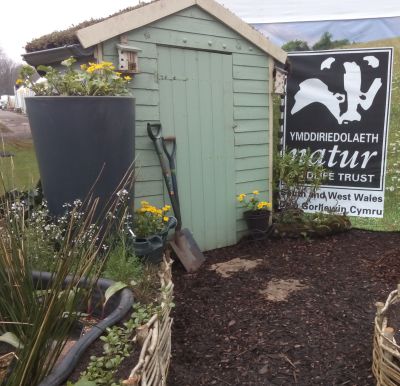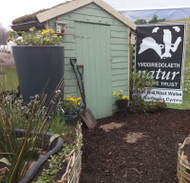Rain Gardening with the Wildlife Trust
Posted by Celtic Sustainables on 1st May 2018
 Creating a Rain Garden might be one of the hottest landscape trends around but what is all the fuss about? We volunteered with The Wildlife Trust of South and West Wales at the RHS Cardiff Flower show earlier this year to find out.
Creating a Rain Garden might be one of the hottest landscape trends around but what is all the fuss about? We volunteered with The Wildlife Trust of South and West Wales at the RHS Cardiff Flower show earlier this year to find out.
The term “Rain Garden” has changed over the years. Technically it has always been just one aspect of the design of Sustainable Urban Drainage Systems (SuDS) and referred to a type of soft landscaping that slows the flow of rainwater via small planted “puddles” before it reaches the drain or gulleys. A Rain Garden now tends to encompass a whole range of garden design components including soft landscaping like swales, hard landscaping like infiltration trenches and soakaways, green roofs, water butts, water features and ponds. Essentially anything that attenuates or slow downs rainwater to help prevent flooding either through increased infiltration into the ground, slowing the flow of water to a watercourse or drainage system or storing rainwater in the garden for use at a later date or within the home for non-potable purposes.
Rebecca Vincent from The Wildlife Trust of South and West Wales explained:
“Our rivers are under a huge amount of stress in the UK, with increased urbanisation changing the natural flow of water, leading to increased water pollution and flooding. By creating a rain garden you can improve your local area for wildlife. What ever the style, rain gardens all share a common goal; to capture water in a beautiful and wildlife-friendly way!”
The idea in general is that water is slowed down (attenuated) to such an extent that the peak flow into rivers is decreased so much that the area downstream doesn’t flood. If everyone in an area makes small changes, a significant amount of storm water could be temporarily stored and the scale of damage during a flood event dramatically reduced.

This simple Hydrograph shows the time lapse from it raining to the water arriving in a River with the aim of slowing the flow of water to keep it under the flooding (target discharge rate) level. Image from Slow the Flow Calderdale.
Rain Gardens can be adapted to any outdoor urban space, including concreted gardens and school yards. They should ideally be planted with a variety of wildlife-friendly plants which will look beautiful whilst also supporting pollinators such as Bumblebees and Butterflies. As with the Trust’s Garden at the Flower Show, they are often planted with native vegetation.
The Garden was certainly put to the test at the Show. It rained and rained! When comparing the water dripping from the Green Roof on the Shed to the marquee roof, I observed that there was that no rain was making it’s way from the sedum planted roof into the guttering during those April showers so it was working.
Design elements to create a wildlife friendly Rain Garden

The main components the Wildlife Trust used in their wildlife friendly Rain Garden were:
- Water Butt (Rainbowl Flower water butt with built-in Planter):
The water butt harvests rainwater via a downpipe diverter. The rain water can then be used to water plants, wash cars, flush toilets and run washing machines. The Diverter used in this instance also filters the rainwater before it is stored. - Green Roof (Sedum vegetation mat):
Green Roofs can slow water by up to 50% depending on the type of green roof. This Sedum green roof is on a thin substrate over a plastic root and water barrier over the Shed’s wooden roof. They also provide insulation and create a habitat for wildlife. - Solitary Insect Houses:
One disadvantage of Rainwater is often cited as being an increase in water (and human) loving insects like mosquitoes. You can readdress the balance by adding more wildlife homes in your garden. - Rain Chain:
A Rain Chain links your guttering to a planted pot or drain. They guide water visibly and create a pleasing water feature. - Bird Table:
A bird table will attract birds to feed in your garden, birds like eating insects like mosquitoes too so be sure to include at least one in your wildlife friendly design. - Water Fountain:
The Trust’s Rain Garden included a solar powered water feature which if included in a retention pond would also slow storm water and oxygenate the water for wildlife. - Large Planter:
This large planter is designed to hold water at the base and slowly release it into the wider environment. It had different layers of soil, sand and gravel filter and hold the water. It could be used over permeable paving or other hard landscaping to increase the water holding capacity of the design. - Retention Pond:
This pond had different water levels and a number of rocks to help wildlife navigate to out of the pond. Ponds are great for wildlife and wonderful for holding water.
The hedgehog willow sculpture to the right of the photograph reminds us that with increased rainfall comes more slugs. Creating habitats that hedgehogs love will ensure they wander around your garden at night eating those slugs.
Planting a Rainwater Garden
The garden was planted with native UK plants suitable for wet and boggy areas including: Marsh Marigold, Snake’s-head Fritillary and Ragged Robin to name a few. Plants were chosen to suit the environment and to give all year colour.


